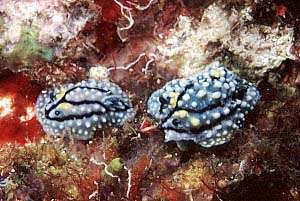
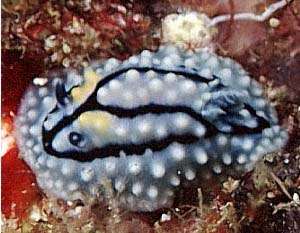
Aldisa erwinkoehleri
Perrone, 2001
Order: NUDIBRANCHIA
Suborder: DORIDINA
Superfamily: EUDORIDOIDEA
Family: Dorididae
PHOTO
Thailand. In the lower photo the gills can be clearly seen. PHOTOS: Michael Miller.
Another remarkable phyllidiid mimic, reported by Michael Miller in his message below. In this case the dorid is probably best described as a Phyllidia mimic. Compare with Discodoris? liturata, a Phyllidiella mimic. There is also a general mimicry page where flatworm and chromodorid mimics of phyllidiids are described.
NOTE: This species was previously known on the Forum as Doris? sp. 2.
Reference:
• Perrone, A. (2001) A new species of Nudibranchia of the genus Aldisa Bergh (Gastropoda, Opisthobranchia) Basteria, 65: 105-116
Rudman, W.B., 2002 (March 11) Aldisa erwinkoehleri Perrone, 2001. [In] Sea Slug Forum. Australian Museum, Sydney. Available from http://www.seaslugforum.net/find/aldierwi
Related messages
Aldisa erwinkoehleri from Thailand [2]
February 5, 2009
From: Marcel Tanke
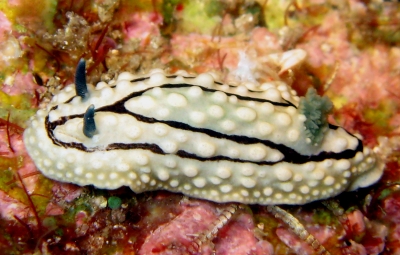
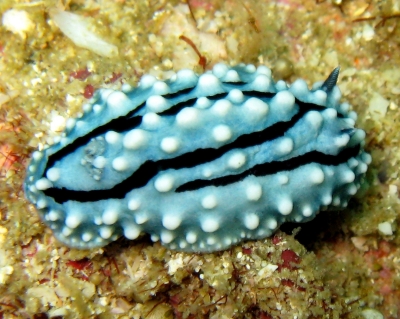
Hi Bill,
Here are the other 3 other pictures of the Aldisa, as per my previous message [#22213].
Locality: Phi Phi and Simalan Islands, About 15 m, Thailand, Ademan Sea, January 2009. Length: about 2 cm. Photographer: Marcel Tanke.
Best regards,
Marcel
marceltanke@cs.com
Tanke, M.A., 2009 (Feb 5) Aldisa erwinkoehleri from Thailand [2]. [Message in] Sea Slug Forum. Australian Museum, Sydney. Available from http://www.seaslugforum.net/find/22214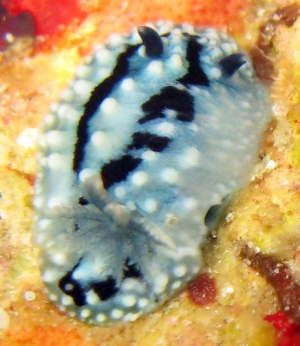
Dear Marcel,
Although these animals lack yellow, the blackish rhinophores and the forked shape of the black mantle pattern. suggest to me that these are also Aldisa erwinkoehleri rather than A. williamsi.
Best wishes,
Bill Rudman
Aldisa erwinkoehleri from Thailand, laying red eggs [1]
February 5, 2009
From: Marcel Tanke

Concerning message #10912:
Hi Bill,
On our trip to Thailand, Ademan Sea, Phi Phi- and Similan Islands I found several Aldisa williamsi. The first picture here shows one laying red eggs, a color that I did not expect from a bluish / white / black animal.
Interesting colors variations: picture 2 shows some yellow postules and picture 3 shows one yellow pustule and maybe some yellow color on the edge of the mantle.
I am sending 3 Other regular (?) specimens in a separate message [#22214 ].
Locality: Phi Phi and Similan islands area's, 10-15 meters, Thailand, Ademan Sea, January 2009. Length: about 2 cm. Photographer: Marcel Tanke.
Best regards,
Marcel
marceltanke@cs.com
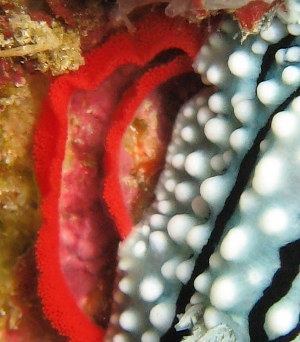
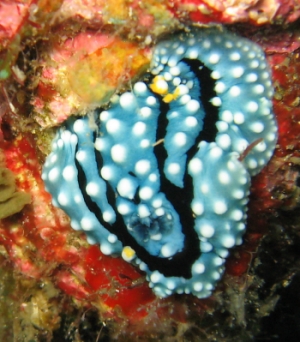
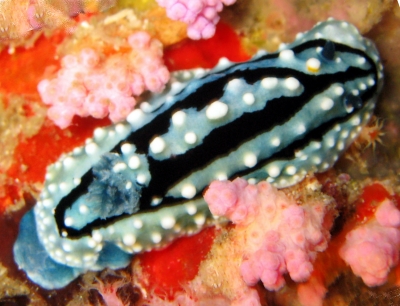
Dear Marcel,
This is a similar species Aldisa erwinkoehleri which has this forked black pattern on the mantle and some yellow pustules. The red egg string is interesting. Perhaps it is a clue that the bright red sponge near the animal in the lower photo is their food? Quite a few species of Aldisa are red and feed on red sponges.
Best wishes,
Bill Rudman
Aldisa erwinkoehleri from the Andaman Sea
March 23, 2007
From: David Scheel
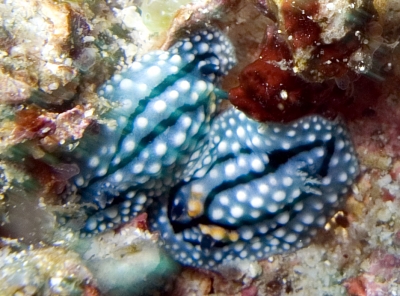
Bill,
I have been unable to identify the Dorids in this photograph. Are you able to? They seem likely to be Phyllidiidae based on over-all appearance (perhaps Phyllidiella or Phyllidiopsis, judging by bi-colored white and black rhinopores, orange and white tubercules, blue ground with black stripes). Unfortunately, I did not turn them over to check for medial stripe on the foot.
I have looked through images of that family on your site, however, and was unable to find a match. Phyllidia and Phyllidiella species were common on other dives I did in the Similans around the same time.
Place: Deep Six, Koh Payoo, Similan Islands, Thailand, Andaman Sea. Depth: 30 feet. Length: approximately 1-2 cm. 8 February 2007. Rocky reef
Photographer: D. Scheel
Thanks for any information you can provide.
Cheers,
David Scheel
Alaska Pacific University
dscheel@alaskapacific.edu
Scheel, D., 2007 (Mar 23) Aldisa erwinkoehleri from the Andaman Sea. [Message in] Sea Slug Forum. Australian Museum, Sydney. Available from http://www.seaslugforum.net/find/19740
Dear David,
You seem to have made a good attempt to identify these animals but you have missed one vital clue - dorsal gills. In the close-up alongside we can see a circle of gills in the posterior dorsal midline - a common feature in dorid nudibranchs, but one which is missing in all members of the Phyllidiidae.
This is the recently named Aldisa erwinkoehleri, one of a growing number of phyllidiid mimics which are being discovered [see mimicry Fact Sheet]. One reason that phyllidiids are often the most commonly seen nudibranchs - especially during daylight hours - is that they contain extremely disasteful chemicals in their mantle, which deter fish from eating them. As often occurs in nature when someone comes up with a good survival strategy, a number of dorids, often unrelated to each other, have decided to mimic phyllidiids so that they also look distasteful to hungry fish.
Best wishes,
Bill Rudman
Aldisa erwinkoehleri - another species update
March 13, 2002
From: Dave Behrens
Bill:
Another species update. The animal called Doris? sp. 2 on the Forum has been named Aldisa erwinkoehleri Perrone, 2001. We all recognize its name, as that of the creator of great web site listing/linking every opisthobranch image on the internet.
Reference:
• Perrone, A. (2001) A new species of Nudibranchia of the genus Aldisa Bergh (Gastropoda, Opisthobranchia). Basteria, 65: 105-116
Dave Behrens
dave@seachallengers.com
Behrens, D., 2002 (Mar 13) Aldisa erwinkoehleri - another species update. [Message in] Sea Slug Forum. Australian Museum, Sydney. Available from http://www.seaslugforum.net/find/6412Thanks Dave,
Erwin told me of this a few weeks ago and I have been waiting to see the publication, which finally arrived a week ago. I used to think of Aldisa as a genus of red dorids which mimicked sponges, but now it seems they include a group of nodulose species which mimic phylidiids.
best wishes,
Bill Rudman
Phyllidia-mimic from Thailand
January 19, 2000
From: Pauli Kuusisto
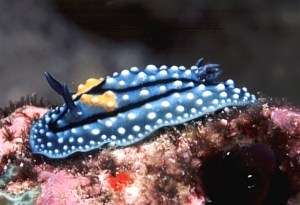
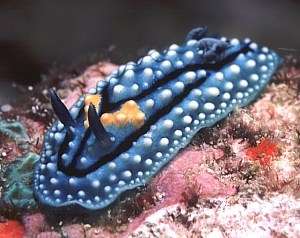
Dear Bill
Found one more of the mimic Doris sp. 2 at Ko Bon , Thailand.
There were two similar looking animals close to each other but unfortunately we did not look closer at the other.
Picture taken at 10 mtrs, rocky bottom. Animal length approx 2 cm
Pauli Kuusisto
pauli@loxinfo.co.th
Kuusisto, P., 2000 (Jan 19) Phyllidia-mimic from Thailand. [Message in] Sea Slug Forum. Australian Museum, Sydney. Available from http://www.seaslugforum.net/find/1749Dear Pauli,
Thanks very much for the great photos. Your email address suggests you are permanently based in Thailand. I would welcome other photos if you have them, and some background information on your interests for the Participants List.
Best wishes,
Bill Rudman.
Phyllidia mimics again
July 3, 1999
From: Erwin Koehler
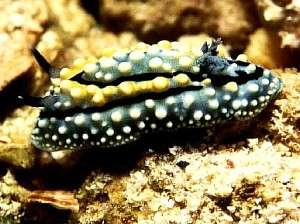
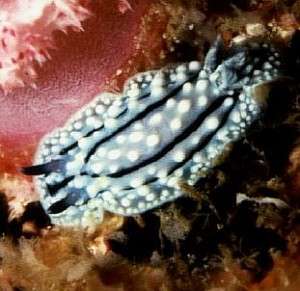
Bill,
attached 2 photos by Georg Heinze: Thailand, Similan Is., March 1999, size unknown. Colour-variants or different species?
Erwin
Medslugs.Koehler@t-online.de
Dear Erwin,
I think they are both what I am calling here Doris? sp. 2. One seems to have more yellow than usual and the other less than usual, but the black lines and arrangement of tubercles seem to be constant.
Bill Rudman.
Rudman, W.B., 1999 (Jul 3). Comment on Phyllidia mimics again by Erwin Koehler. [Message in] Sea Slug Forum. Australian Museum, Sydney. Available from http://www.seaslugforum.net/find/1012Another amazing phyllidiid mimic
December 31, 1998
From: Michael Miller

Dear Bill,
In reviewing my slide collection of Phyllidiids(?), I came across a pic taken almost 10 years ago in Thailand. As a result of the discussion on your site regarding Phyllidiid mimics, care was taken to see if any exhibited gills. Sure enough, much to my surprise a pair did!!! Have attached same for your review. Hope the digital rendition has sufficient resolution to see the gills!!
Happy New Year;
Mike
mdmiller@cts.com


Thanks Mike,
The gills can be seen loud & clear!
Perhaps your find will send some others back to their slide collections! I would say your animal is a different species from the one we are calling Discodoris? liturata. Any information on size, date and locality would be useful for future reference. Your animals remind me of a species of Phyllidia whereas Discodoris? liturata looks like a Phyllidiella.
Best wishes,
Bill Rudman.
